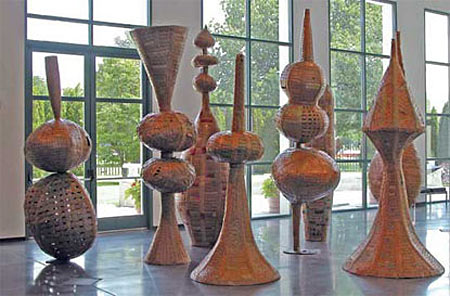
Contemporary sculpture is flush with work that erases the boundaries between fine art and craft, merging the two sensibilities to transcend traditional categories and bring a new humanism to the art form. California sculptor Ann Weber is tapped into this zeitgeist, creating organic forms out of non-organic materials, i.e., found corrugated cardboard, staples and polyurethane or shellac finishes. The results are idiosyncratic and sometimes surprisingly beautiful, offering a distinctive view of natural and sculptural form. Weber’s show at the Boise Art Museum through November entitled “Corrugated,” offers a decade of freestanding and wall-mounted sculpture and reliefs, revealing an oeuvre alternating between a calm, natural elegance and a quirky playfulness. This split personality is at least in part attributable to her extensive background in ceramics. After fifteen years of making functional pottery, Weber completed an MFA in ceramic sculpture at the California College of Arts and Crafts. Her switch to cardboard was motivated by the difficulties she encountered making oversized works in clay. Lightweight, flexible cardboard has allowed Weber to pursue her aesthetic flights of fancy on a monumental scale. At the same time, her sculpture has retained an emphasis on rounded forms common to pottery which tends to limit her formal repertoire. Despite this abstract orientation, Weber’s floor pieces in particular are unmistakably figurative, sometimes in a totemic sense, but more often in their anthropomorphic disposition.
